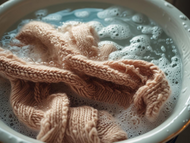Care Instructions: How to Protect Your Handmade Treasures
Posted by Kelly Holtsclaw on Jul 8th 2025
Wondering how to care for handspun yarn projects? Caring for handspun yarn projects properly is essential to keep your handmade knit or crochet creations looking beautiful for years to come.
You’ve poured your heart, time, and skill into creating a beautiful knitting or crochet project from handspun yarn. It’s an heirloom, a labor of love—but do you know how to properly care for it? One of the biggest “gotchas” in the fiber arts world is improper washing and care, which can ruin precious handmade items.
Don’t let your beautiful work shrink, felt, or lose its shape! In this guide, we’ll walk you through the essential care instructions for handspun yarn projects, ensuring your unique creations stay beautiful for years to come.
Why Proper Care is Crucial for Handspun Yarn
Handspun yarn is different from commercially processed yarn. It often retains more of its natural lanolin (in wool), has varying twists, and may be composed of delicate or exotic fibers. This means it requires a more thoughtful approach to care than your average acrylic.
- Prevent Felting: Wool fibers have scales that can interlock and shrink when exposed to heat, agitation, and moisture. This is how felt is made, and it can irrevocably shrink your sweater!
- Maintain Shape and Drape: Proper blocking and drying methods prevent stretching or distortion, ensuring your project retains its intended shape and drape.
- Preserve Color and Luster: Gentle care helps maintain the vibrant colors and natural sheen of your handspun masterpiece.
The Golden Rules for Washing Handspun Yarn Projects
Avoid the biggest “gotchas” with these essential steps:
1. Hand Wash Only (No Washing Machine!):
Unless specifically stated as “superwash,” always hand wash your handspun wool items. Even superwash wools benefit from gentle handwashing to prolong their life.
Steps for Hand Washing:
- Prepare Your Bath: Fill a clean basin with lukewarm water (around body temperature—not hot!). Add a small amount of a gentle wool wash or soap made specifically for wool. Avoid harsh detergents like woolite or detergent.
- Submerge Gently: Carefully submerge your item. Do NOT agitate, scrub, or twist the fabric. Let it soak for 20-30 minutes, allowing the water to penetrate the fibers.
- Rinse Thoroughly: Gently drain the soapy water and refill the basin with clean, lukewarm water. Press water through the fabric without rinsing or twisting. Repeat until the water runs clear.
- Remove Excess Water: Carefully lift the item, supporting its weight as you do so. Gently press out as much water as possible. Do NOT wring or twist, as this can stretch or felt the fibers.
2. Block and Dry Properly (The Lay-Flat Method):
Drying is just as important as washing for maintaining shape.
- Roll in a Towel: Lay your item flat on a clean, dry towel. Roll the item up tightly in the towel, pressing gently to absorb as much water as possible. You might need to repeat this with a second dry towel.
- Shape and Pin: Lay your damp item flat on a clean, dry surface (like a blocking mat or another dry towel). Gently shape it according to its finished dimensions, smoothing out edges and curves. Use blocking pins to hold its shape.
- Air Dry Completely: Allow the item to air dry completely, turning it periodically to ensure even drying. Keep it away from direct sunlight or high heat sources. Depending on the fiber and thickness, this can take 24-48 hours, or even longer.
3. Storage and Maintenance for Longevity:
Once your handspun treasure is clean and dry, proper storage will keep it pristine:
- Fold, Don’t Hang: Always fold knitted or crocheted items made from handspun yarn. Hanging can stretch them out, especially sweaters.
- Protect from Pests: Store items in breathable bags or containers with cedar balls or lavender sachets to deter moths and other pests. Avoid plastic bags, which can trap moisture.
- Spot Clean: For small spills or stains, try spot cleaning with a damp cloth and mild soap rather than re-washing the entire garment.
Special Considerations for Different Handspun Fibers
While these general rules apply, remember that different fibers in your handspun (like those in our handspun DK weight yarns) might have unique needs:
- Fine Wools (like Merino): Can be more prone to felting, so be extra gentle.
- Lustrous Fibers (like Silk or Alpaca): May require even less agitation to prevent dulling their sheen.
- Blends: Consider the most delicate fiber in the blend when deciding on care.
Cherish Your Handmade Creations
Caring for your handspun yarn projects might seem like a lot of work, but these simple steps ensure your treasured creations last a lifetime. By following these care instructions, you’re not just maintaining a piece of clothing—you’re preserving a work of art.
Need the right tools for handwashing and blocking? Explore our collection of high-quality yarns, notions (including wool wash and blocking pins), and tools today!
Keep your handmade treasures beautiful: https://foreverwindingwool.com/

